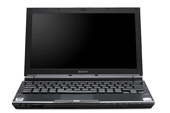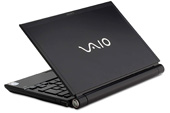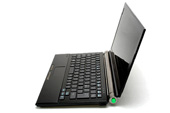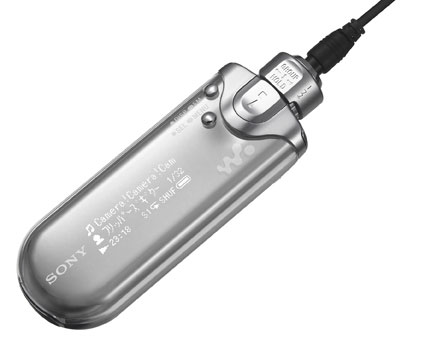May 11th, 2007
Over at Notebook Review, I noticed that details of Sony’s VAIO TZ were released. It looks like the next generation T-series is a design update to their venerable ultraportable line. Taking design cues from their groundbreaking VAIO X505 product, the new TZ really does look elegant.



The specifications are modestly updated and makes for a compelling ultra mobile solution. That did get me thinking that it’s a little underwhelming considering the release of Intel’s new Centrino platform (Santa Rosa). The reason why I feel it’s a little underwhelming is because some of the new technologies in the Santa Rosa-based platform would be perfect for this form factor.
Aside from the slightly better integrated graphics (Intel X3100 vs. Intel GMA950), the updated 802.11n wireless networking, and better overall power management, the new platform also adds a new option called Intel Turbo Memory. This technology, formerly called Robson, is additional flash cache memory that works with Windows Vista and enables Vista ReadyDrive with any hard disk. In essence, it gives some of the performance benefits that having a hybrid hard drive will allegedly have. Given that the T-series uses 4200RPM 1.8” hard disks, something like Intel Turbo Memory (assuming it works) would help a lot since since the hard disk is the bottleneck in the system. Also, this technology should allow for even better battery life (which is already excellent). I suspect the main reason why they didn’t go with the new platform is because there is no Ultra Low Voltage (ULV) processor in the family yet. The T-series has always used ULV processors and the current line only has Low Voltage (LV) processors.
At any rate, it’s a great looking system that is solid but I eagerly await the next version that takes advantage of this next generation platform.
September 7th, 2005
A while back I put the Sony NW-Exxx series on my droolworthy list and I even purchased the top end model since I was so enamoured with the product. Sony wasn’t sitting still and has announced a new revision of the series with a new model numbering scheme. Rechristened the NW-A6xx series, the new models increase capacity, add new functionality, and address some of the issues I had with the unit in my in-depth review.
The new models comprise the following:
NW-A608, 2GB - ¥32,000 (USD$290) *available colors: Violet, Silver, Blue and Pink; Limited Edition Color - Emerald Blue and Gold ¥30,000
NW-A607, 1GB - ¥27,000 (USD$245) *available colors: Violet, Silver, Blue and Pink; Limited Edition Color - Gold ¥25,000
NW-A605, 512MB - ¥22,000 (USD$199) *available colors: Violet, Silver, Blue and Pink
NW-A600 Series | Features & Specifications
- new “Intelligent shuffle” feature: 1) Most frequently listened tunes shuffle mode, 2) Time/Date based shuffle mode, 3) Artist link shuffle mode and 4) Sports shuffle mode.
- beautiful OLED screen display
- features digital sound presets ~ adjustable bass and treble; up to 8 different stages.
- utilize new “CONNECT Player” software
- High-speed USB 2.0(*1)
- FM tuner: Reception frequency is FM:76.0-90.0MHz, and TV:1-3ch.
- built-in lithium ion battery
- 50 hours music playback; rated at ATRAC 132kbps mode with power saving mode
- support MP3 ~ 32-320 kbps, ATRAC3 ~ 66/105/132 kbps and ATRAC3plus ~ 48/64/96/128/160/192/256/320 kbps. *WMA support will be enabled via a firmware update this December 2005.
- Jog shuffle control dial
- Stylish headphone that matches to each main body color
- Clock/Day display
- Size: 84.9 × 28.8 × 13.9mm (depth, height, width)
- Mass: approx. 48g
NW-A600 Series | Accessories
- “CONNECT Player” (CD-ROM)
- USB cable
- Quick start guide
- Smart clip
- Carrying pouch
- Matching color headphones
In addition to the new hardware, Sony will finally release a new version of their software simply called “Connect”. Basically, they’ve gotten rid of SonicStage and redesigned the new software to be much easier to use.
Available in November, it will definitely make me considering upgrading to a new unit…unless something else cooler comes out…
After years of waiting, this is basically the iPod I have been waiting for in terms of form factor and functionality. The size is somewhere in between the iPod Shuffle and the now dead iPod Mini and they’ve managed to add a color screen to the mix.
Available in 2GB and 4GB sizes and in black and white colors, the iPod nano is more of a shrunken iPod Photo than it is an iPod mini. It sports a 1.5” LCD with an LED backlight (all the rage nowadays) and supports all your favorite iPod compatible audio codecs (MP3, AAC, Audible, etc.). At 1.5 oz., it’s very light and it’s slim size will make it easily fit in any geek’s gearbag.
The one thing I’m down on is the less than stellar battery life of 14 hours especially when my Sony digital audio players get 18-50 hours of battery life. I would have liked to see them up that to 20 hours even at the expense of a few ounces of weight.
One other thing that sucks is that the cradle is extra. I don’t see why they don’t just include it since most people are going to want it in the first place. Also, I’m not too sure about having the headphone jack on the bottom of the unit. It seems like it would be awkward especially when using the armband accessory.
At any rate, this product will go on my droolworthy list since the pricing is decent, the design is excellent, and it’s a testament to Apple’s ability to produce a refined and mature product. I’ll also bet money that an 8GB version will be available later this year or more likely early next year which would be the perfect capacity for this killer device. Prices start at $199 for the 2GB version and $249 for the 4GB version.
More info can be found at http://www.apple.com/ipodnano/
August 29th, 2005
Sony announced the newest line in their T-series subnotebooks. Dubbed the TX-series, the new line brings a new design and further refinements (and a few firsts for Sony) to the series.
The screen is now 11.1†(half an inch larger than the previous series). The new resolution is a 16:9 1366x768 resolution. The screen now uses a LED backlight system instead of a CCFL (Cold Cathode Flourescent Light) which should allow it to be 30% brighter than current Sony screens while consuming less energy. Additionally, the use of a LED backlight allows the screen to be 50% thinner than previous designs.
The top lid uses “multiple layers of carbon fiber†for less weight but twice the strength. As you can see from the photos, the screen thickness is ridiculously thin! Overall, the size has been trimmed down and the notebook is lighter than ever. The size goes from 21mm (.83 inches) to 28.5mm (1.1 inches) and it only weighs 1.25kg (2.75lbs).
The processor remains the newer Sonoma Pentium M 753 1.2GHz Ultra Low Voltage CPU with an optional Celeron model for budget buyers. It’s coupled with the 915GM chipset which integrates video (Intel’s GMA900 which uses up to 128MB of system memory) and the new High Definition Azalia audio.
The memory now only goes up to 1.5GB maximum since 512MB is built-in onboard and there’s only one expansion slot. The good thing is that Sony is using a standard SO-DIMM DDR2.
60GB is the maximum hard disk size that’s shipping. This leads me to believe that it’s still 1.8†HDD. I suspect 80GB models will be available next year once those are produced in volume by Toshiba.
The new multiformat burner supports the following formats at the corresponding burn speeds. DVD+R DL (2.4x), DVD+R (4x), DVD+RW(2.4x), DVD-R (4x), DVD-RW (2x), DVD-RAM (2x), CD-R (24x), and CD-RW (24x).
Due to the energy enhancements and newer (possibly larger) battery capacities, the standard battery life is now 9 hours with the extended battery lasting up to 14.5 hours!
The keypad pitch is 17mm (no change here) and it uses the familiar trackpad for navigation. Below the screen on the spine there are media buttons. There are now direct volume buttons located on the front of the notebook near the headphone/microphone jacks.
A welcome change for most people and probably a shocker is the inclusion of a SD/MMC memory slot in addition to the usual Memory Stick (DUO/PRO) slot.
In terms of wireless connectivity, the TX offers 802.11a/b/g (likely Intel’s 2915ABG chipset) and Bluetooth. The Bluetooth specification has been upgraded to 2.0 and it seems to offer direct Bluetooth headset support so you can use it with Skype (which is preinstalled) and heavily hyped on their website.
The new AC adapter is super small only weighing 180g with dimensions of 86 x 21.7 x 58.4 (WHD).
Other notable specs not already mentioned:
2 x USB 2.0 ports
1 x iLink (4-pin) Firewire
1 x Ethernet 10/100 RJ45
1 x Modem RJ11 jack
1 x Stereo headphone mini-jack
1 x Microphone input jack
1 x External VGA DB15-pin
Type II x1, Cardbus slot
Port Replicator available
Available in White, Black, or a limited edition Premium Blue, the TX looks to continue the family line since the creation of the venerable TR series.
February 21st, 2005
Sony’s late entries into the “mp3” market are starting to come at a rapid pace. Few people imagined that Sony would actually follow through on their promise to embrace MP3s in their digital audio players. Sony has already started with the HDD based players but they’re struggling to catch up with Apple who has recently started selling the iPod Shuffle flash-based players.
Sony’s forthcoming 512MB or 1GB (E407 model) entry looks darned sexy:

Known specifications:
- OLED Screen
- FM Radio
- 50 hour lithium battery
- 37 grams
And yes, it has a screen. It’s my personal opinion that a 512MB+ type device needs to have some sort of a screen. I’ve been using a 512MB flash-based MP3 player for the last year and having a screen is absolutely necessary. I do use the random shuffle feature but I often want to hear a specific song or group of songs (like when I’m teaching dance class or when I’m at the gym working out). Without the option of having a screen to easily navigate to my music a device isn’t exactly useful.
What Sony will need to do is provide a better software interface. As a user of OpenMG Jukebox 1.0 to SonicStage 2.3, I must say that Sony’s software is absolutely atrocious. For the most part, most of Sony’s draconian DRM measures are gone or finally transparent which is good. However, the user interface of their software is cryptic and poorly designed. Sony has this fascination with creating their own interfaces which often waste screen real estate and don’t follow traditional user interface conventions. Allegedly, SonicStage 3.0 will be a complete rewrite that will finally be worthy of mention. For Sony’s new push into digital audio players, the end-to-end experience is going to have to be very good if they want a shot of claiming back some of the market place.
Page 1 of 3 pages 1 2 3 >





